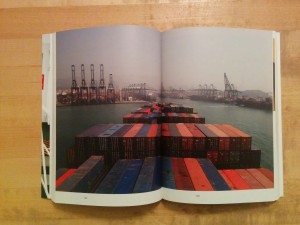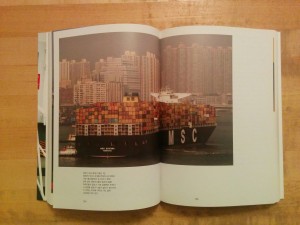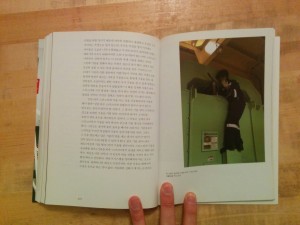 Photographing at night exposes the world in a new light. We are able to see things in ways that we cannot during daylight hours. Taewon Jang has gone out into the darkness to photograph stalled construction projects, remnants of abandoned factories and the nocturnal glow of functioning industrial sites so that we can see them, literally, in a different light.
Photographing at night exposes the world in a new light. We are able to see things in ways that we cannot during daylight hours. Taewon Jang has gone out into the darkness to photograph stalled construction projects, remnants of abandoned factories and the nocturnal glow of functioning industrial sites so that we can see them, literally, in a different light.
The light of the night is the opposite of the light of day. Daylight is external and falls onto the world–and does so with relative equality. At night, light jets outward from the subjects and pools close to its source leaving the rest of the world dark. By photographing at night–and by making use of the long exposures required by his large format camera, Jang traces the power relations (literal and metaphorical) of contemporary society.
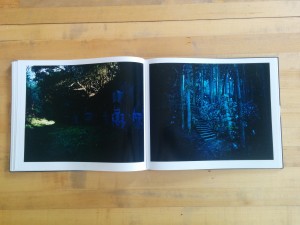 Jang began making photographs in Korea and Japan of stalled construction sites. Over the seven year period during which he photographed, he expanded his subject matter to include abandoned factories and functioning industrial sites as well as expanded his geographic area to include the United States. In total, he has photographed almost 400 different sites. Seventy-seven of these appear in Stained Ground.
Jang began making photographs in Korea and Japan of stalled construction sites. Over the seven year period during which he photographed, he expanded his subject matter to include abandoned factories and functioning industrial sites as well as expanded his geographic area to include the United States. In total, he has photographed almost 400 different sites. Seventy-seven of these appear in Stained Ground.
Distilling physical objects and their complex outer appearances into photographic form gave way to seeking evidence of the deep structures of our social contract. What is interesting is how the subjects suggest not only the social developments that begat them but also the continual development that will later consign them to obsolescence.
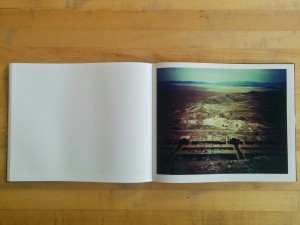 He describes the way his subjects evolved over the course of the seven year project in an interview with Suejin Shin included in the book: “In the beginning, I concentrated on the specific topography or the architecture, or perhaps a structure, or construction equipment, thinking that these elements could reveal the strange tension I felt at the site[s]… But then as I continued working on this project for a long time, I came to realize that what I saw was only a very small part of a larger picture… the places I photographed have changed beyond recognition or have even vanished from the map.”
He describes the way his subjects evolved over the course of the seven year project in an interview with Suejin Shin included in the book: “In the beginning, I concentrated on the specific topography or the architecture, or perhaps a structure, or construction equipment, thinking that these elements could reveal the strange tension I felt at the site[s]… But then as I continued working on this project for a long time, I came to realize that what I saw was only a very small part of a larger picture… the places I photographed have changed beyond recognition or have even vanished from the map.”
The light that illuminates these subjects and suffuses the photographs with an ethereal glow is itself a product of the development that these photographs trace. Likewise, Jang’s ability to photograph is a product of the development. Without the progress of the first and second industrial revolutions (and that continues in the third industrial–or technological, revolution of the present day) these photographs could not exist and their subjects would not exist. The advancements of each revolution bring about new technologies and new industries while leaving behind the old and setting the foundation for the next.
The last three photographs of Stained Ground can be read as a coda for understanding the book: In “SG U #415, 2013”, a vast windfarm spreads across the frame. Each windmill is marked off by the red glow of its warning light. The movement of some of the turbines’ blades over the course of the long exposure has blurred them into nothingness. In the background a miasma of green light sets off the dark and skewed horizon. Our own technology appears as “other.” The scene suggests both a technological miracle and an apocalypse brought about by the chain of changes these machines are intended, at least in part, to solve. The next photograph, “SG U #321, 2007,” is of a small, low industrial building. It’s garage door is dark but open–we can see the dim form of a white chair inside. To the right, the bare spindly branches of a tree loom over the building as if about to collapse onto it. 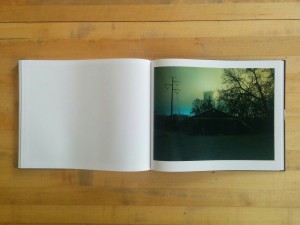 In the background the cooling towers of a power plant hover in a haze of brackish yellow clouds. Running from the foreground to the background in the left of the frame are high-tension power lines. They run straight back to a patch of blue cloud along the far horizon. The path to our current state has run along a line of iterative steps. Each successive revolution has brought the next. Photographically, the book ends with “SG K #420, 2007”. This photograph is one of only a handful that includes people and is the only photograph in which people are central. A group of 9 men (I assume they are men) are in a line in the center of the frame. They are dwarfed by the night around them. Five stand while four crouch or sit huddled on the ground. A line of hills run along the horizon and are dark against a multicolored sky. The ground on which the men are set is orange and indistinct. It is unclear if this is where perhaps some original industrial beginning occurred or where and how we’ll be left at some point in the future after our industry has run us to ground.
In the background the cooling towers of a power plant hover in a haze of brackish yellow clouds. Running from the foreground to the background in the left of the frame are high-tension power lines. They run straight back to a patch of blue cloud along the far horizon. The path to our current state has run along a line of iterative steps. Each successive revolution has brought the next. Photographically, the book ends with “SG K #420, 2007”. This photograph is one of only a handful that includes people and is the only photograph in which people are central. A group of 9 men (I assume they are men) are in a line in the center of the frame. They are dwarfed by the night around them. Five stand while four crouch or sit huddled on the ground. A line of hills run along the horizon and are dark against a multicolored sky. The ground on which the men are set is orange and indistinct. It is unclear if this is where perhaps some original industrial beginning occurred or where and how we’ll be left at some point in the future after our industry has run us to ground.
This is beautiful work and powerfully moving–in spite of the book’s humdrum design. As an object, Stained Ground is disappointing. As a point of comparison with another recent Hatje Cantz, Bae Bien-U’s Windscape‘s design pays attention to small details like the use of different papers for the text and plates and the use of a translucent matte dust-jacket that evokes the soft light of the photographs within. By comparison, Stained Ground lacks these small book maker’s touches. The cover is a good example of this: it is a garish glossy wrap with the title lost in the tones of the photograph over which it is set. Looking at Jang’s previous book, Black Midday, one sees a somewhat lower production value but a significantly greater attention to the design.
Stained Ground is a nice book to have on the shelf but not a necessary one. It doesn’t elicit delight. While it may seem odd to suggest that this should be the goal of a book whose subject matter is so somber, art books ought to be as much an object of delight as a carrier of content. One could imagine and certainly desire that design might have better served as mirror and amplifier to the content of Stained Ground. None of this is meant to discount the power of the photographs which are necessary and ought to be seen.
Stained Ground
Taewon Jang (site)
Edited by Suejin Shin and Markus Hartmann
Copyediting: Leina Gonzalez
Graphic Design and Typesetting: Andreas Platzgummer, Hatje Cantz
Production: Nadine Schmidt, Hatje Cantz
Typeface: Thesis, The Sans
Reproductions: Jan Scheffler, prints professional
Paper: Galaxi Keramik
Printing and Binding: DZA Druckerei zu Altenberg GmBH, Altenberg
2014
***
A brief post-script: A couple of American photographers making work contemporaneously with Jang are brought to mind by this book. Jang’s “SG U #405, 2013” recalls Mitch Epstein’s, American Power (as well as State of the Union, also published by Hatje Cantz). Epstein’s photographs examine the relationship of American society with industry, primarily in the form of energy production. Epstein places industry as ever present in the background of everyday life. Industry is there, but it remains, just barely, secondary to the human lives that it supports. Like Jang, his photographs are hesitant in passing judgement but present a troubling view. Less ambivalent is Will Steacy. Like Jang, Steacy spent long nights photographing America at night with a large format camera. In Down These Mean Streets, Steacy brought an agitprop sensibility to depicting the plight of the American City–in its archetypal and specific forms. The light in Jang’s photographs may hint at apocalypse and dystopia, but it has none of Steacy’s firebrand anger.
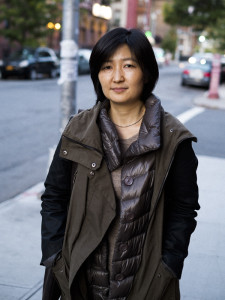 On October 26th, Sangyon Joo of Datz Press came by KPB HQ to talk about her experiences as a publisher, curator and photographer. We’d first met during Printed Matter’s Art Book Fair at PS1 when I stopped by the Datz Press booth. This conversation has been edited for length and clarity.
On October 26th, Sangyon Joo of Datz Press came by KPB HQ to talk about her experiences as a publisher, curator and photographer. We’d first met during Printed Matter’s Art Book Fair at PS1 when I stopped by the Datz Press booth. This conversation has been edited for length and clarity.  Photographing at night exposes the world in a new light. We are able to see things in ways that we cannot during daylight hours. Taewon Jang has gone out into the darkness to photograph stalled construction projects, remnants of abandoned factories and the nocturnal glow of functioning industrial sites so that we can see them, literally, in a different light.
Photographing at night exposes the world in a new light. We are able to see things in ways that we cannot during daylight hours. Taewon Jang has gone out into the darkness to photograph stalled construction projects, remnants of abandoned factories and the nocturnal glow of functioning industrial sites so that we can see them, literally, in a different light.  Jang began making photographs in Korea and Japan of stalled construction sites. Over the seven year period during which he photographed, he expanded his subject matter to include abandoned factories and functioning industrial sites as well as expanded his geographic area to include the United States. In total, he has photographed almost 400 different sites. Seventy-seven of these appear in Stained Ground.
Jang began making photographs in Korea and Japan of stalled construction sites. Over the seven year period during which he photographed, he expanded his subject matter to include abandoned factories and functioning industrial sites as well as expanded his geographic area to include the United States. In total, he has photographed almost 400 different sites. Seventy-seven of these appear in Stained Ground. He describes the way his subjects evolved over the course of the seven year project in an interview with Suejin Shin included in the book: “In the beginning, I concentrated on the specific topography or the architecture, or perhaps a structure, or construction equipment, thinking that these elements could reveal the strange tension I felt at the site[s]… But then as I continued working on this project for a long time, I came to realize that what I saw was only a very small part of a larger picture… the places I photographed have changed beyond recognition or have even vanished from the map.”
He describes the way his subjects evolved over the course of the seven year project in an interview with Suejin Shin included in the book: “In the beginning, I concentrated on the specific topography or the architecture, or perhaps a structure, or construction equipment, thinking that these elements could reveal the strange tension I felt at the site[s]… But then as I continued working on this project for a long time, I came to realize that what I saw was only a very small part of a larger picture… the places I photographed have changed beyond recognition or have even vanished from the map.”  In the background the cooling towers of a power plant hover in a haze of brackish yellow clouds. Running from the foreground to the background in the left of the frame are high-tension power lines. They run straight back to a patch of blue cloud along the far horizon. The path to our current state has run along a line of iterative steps. Each successive revolution has brought the next. Photographically, the book ends with “SG K #420, 2007”. This photograph is one of only a handful that includes people and is the only photograph in which people are central. A group of 9 men (I assume they are men) are in a line in the center of the frame. They are dwarfed by the night around them. Five stand while four crouch or sit huddled on the ground. A line of hills run along the horizon and are dark against a multicolored sky. The ground on which the men are set is orange and indistinct. It is unclear if this is where perhaps some original industrial beginning occurred or where and how we’ll be left at some point in the future after our industry has run us to ground.
In the background the cooling towers of a power plant hover in a haze of brackish yellow clouds. Running from the foreground to the background in the left of the frame are high-tension power lines. They run straight back to a patch of blue cloud along the far horizon. The path to our current state has run along a line of iterative steps. Each successive revolution has brought the next. Photographically, the book ends with “SG K #420, 2007”. This photograph is one of only a handful that includes people and is the only photograph in which people are central. A group of 9 men (I assume they are men) are in a line in the center of the frame. They are dwarfed by the night around them. Five stand while four crouch or sit huddled on the ground. A line of hills run along the horizon and are dark against a multicolored sky. The ground on which the men are set is orange and indistinct. It is unclear if this is where perhaps some original industrial beginning occurred or where and how we’ll be left at some point in the future after our industry has run us to ground. 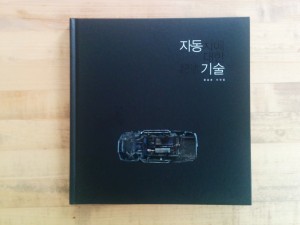 Yoon Seungjun’s Automatic Description is a book of car photographs. These photographs are not your everyday glossy advertisement for this years latest iteration of automotive desire. There is no glitz, no sparkle, no sex appeal. These cars are dead.
Yoon Seungjun’s Automatic Description is a book of car photographs. These photographs are not your everyday glossy advertisement for this years latest iteration of automotive desire. There is no glitz, no sparkle, no sex appeal. These cars are dead.  Automatic Description is broken into chapters that build one upon the other. The book begins with “Anatomical Chart – appropriation,” a typological series of images of individual car’s under carriages shot against a black ground. These photographs reduce the automobile to its basic structural form, minus wheels. We see the body frame with the suspension structures, transmission, driveshaft, and exhaust systems hanging from it. With their wheels removed and reoriented in space, these automobiles are no longer vehicles but rather abstract forms. Looking closely, one can find narratives in the abstraction: oil leaks, broken drive shafts, scrapes, rust and burn (?) marks. There are stories in these forms however banal they might be.
Automatic Description is broken into chapters that build one upon the other. The book begins with “Anatomical Chart – appropriation,” a typological series of images of individual car’s under carriages shot against a black ground. These photographs reduce the automobile to its basic structural form, minus wheels. We see the body frame with the suspension structures, transmission, driveshaft, and exhaust systems hanging from it. With their wheels removed and reoriented in space, these automobiles are no longer vehicles but rather abstract forms. Looking closely, one can find narratives in the abstraction: oil leaks, broken drive shafts, scrapes, rust and burn (?) marks. There are stories in these forms however banal they might be.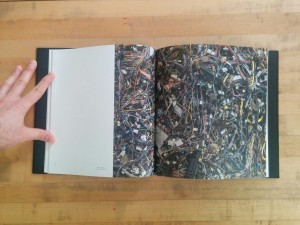 Chapter two, “Anatomical Chart – combination,” moves from individual vehicles to the aggregation of them. Vehicles are no longer individual stories. Instead, they interlock in stacks and heaps. Crumpled cars are crumpled in a pile. Hundreds of gas tanks are mounded together. Wiring harnesses are enmeshed in a chaotic singular mess. Pipes of every description writhe together like so many snakes in a pit. The singular story has given way to a history of multitudes. Yoon brings his camera in close for these photographs. We see no ground; the subject fills the frame. We are again seeing this automotive wreckage as abstraction.
Chapter two, “Anatomical Chart – combination,” moves from individual vehicles to the aggregation of them. Vehicles are no longer individual stories. Instead, they interlock in stacks and heaps. Crumpled cars are crumpled in a pile. Hundreds of gas tanks are mounded together. Wiring harnesses are enmeshed in a chaotic singular mess. Pipes of every description writhe together like so many snakes in a pit. The singular story has given way to a history of multitudes. Yoon brings his camera in close for these photographs. We see no ground; the subject fills the frame. We are again seeing this automotive wreckage as abstraction. 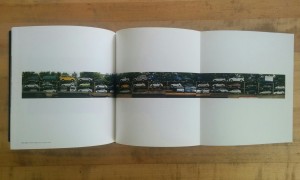 “Scraped Car Chart – parade” is the third chapter and takes us off into the new territory of documentary context. Yoon has pulled back to show us the space in which these cars are resting. We see the rows of racks and risers on which the cars rest. Some of the vehicles are half dismantled; others seem as shiny as new. Sunlight glints off of chrome and polish, still. In the middle of the chapter a gatefold presents a long panoramic image of column after column of junked cars. There are obvious joints in the image; it is not a singular panorama. Yoon has constructed this image–no different than we have constructed this entire infrastructure of disposal (such as it is). Just as the infrastructure of roads, highways and city streets has been built to accommodate the relentless drive of automobile culture so has an infrastructure been built to support the end stage inherent in consumerism. When millions are buying cars, millions are inevitable discarding them as well.
“Scraped Car Chart – parade” is the third chapter and takes us off into the new territory of documentary context. Yoon has pulled back to show us the space in which these cars are resting. We see the rows of racks and risers on which the cars rest. Some of the vehicles are half dismantled; others seem as shiny as new. Sunlight glints off of chrome and polish, still. In the middle of the chapter a gatefold presents a long panoramic image of column after column of junked cars. There are obvious joints in the image; it is not a singular panorama. Yoon has constructed this image–no different than we have constructed this entire infrastructure of disposal (such as it is). Just as the infrastructure of roads, highways and city streets has been built to accommodate the relentless drive of automobile culture so has an infrastructure been built to support the end stage inherent in consumerism. When millions are buying cars, millions are inevitable discarding them as well. 

